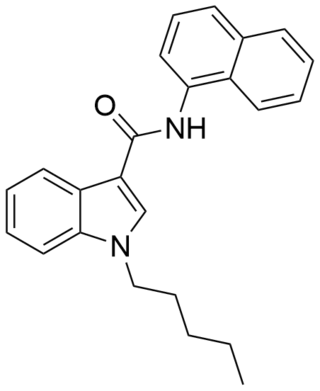
MN 18 is an indazole-based synthetic cannabinoid that is an agonist for the cannabinoid receptors, with Ki values of 45.72 nM at CB1 and 11.098 nM at CB2 and EC50 values of 2.028 nM at CB1 and 1.233 nM at CB2, and has been sold online as a designer drug. It is the indazole core analogue of NNE1. Given the known metabolic liberation (and presence as an impurity) of amantadine in the related compound APINACA, it is suspected that metabolic hydrolysis of the amide group of MN-18 may release 1-naphthylamine, a known carcinogen. MN-18 metabolism has been described in literature.

AB-CHMINACA is an indazole-based synthetic cannabinoid. It is a potent agonist of the CB1 receptor (Ki = 0.78 nM) and CB2 receptor (Ki = 0.45 nM) and fully substitutes for Δ9-THC in rat discrimination studies, while being 16x more potent. Continuing the trend seen in other cannabinoids of this generation, such as AB-FUBINACA and AB-PINACA, it contains a valine amino acid amide residue as part of its structure, where older cannabinoids contained a naphthyl or adamantane residue.

5F-ADB (also known as MDMB-5F-PINACA and 5F-MDMB-PINACA) is an indazole-based synthetic cannabinoid from the indazole-3-carboxamide family, which has been used as an active ingredient in synthetic cannabis products and has been sold online as a designer drug. 5F-ADB is a potent agonist of the CB1 receptor, though it is unclear whether it is selective for this target. 5F-ADB was first identified in November 2014 from post-mortem samples taken from an individual who had died after using a product containing this substance. Subsequent testing identified 5F-ADB to have been present in a total of ten people who had died from unexplained drug overdoses in Japan between September 2014 and December 2014. 5F-ADB is believed to be extremely potent based on the very low levels detected in tissue samples, and appears to be significantly more toxic than earlier synthetic cannabinoid drugs that had previously been sold.

NNE1 (also known as NNEI, MN-24 and AM-6527) is an indole-based synthetic cannabinoid, representing a molecular hybrid of APICA and JWH-018 that is an agonist for the cannabinoid receptors, with Ki values of 60.09 nM at CB1 and 45.298 nM at CB2 and EC50 values of 9.481 nM at CB1 and 1.008 nM at CB2. It was invented by Abbott and has a CB1 receptor pEC50 of 8.9 with around 80x selectivity over the related CB2 receptor. It is suspected that metabolic hydrolysis of the amide group of NNE1 may release 1-naphthylamine, a known carcinogen, given the known metabolic liberation (and presence as an impurity) of amantadine in the related compound APINACA, and NNE1 was banned in New Zealand in 2012 as a temporary class drug to stop it being used as an ingredient in then-legal synthetic cannabis products. NNE1 was subsequently found to be responsible for the death of a man in Japan in 2014.

CUMYL-PICA (SGT-56) is an indole-3-carboxamide based synthetic cannabinoid. It is the α,α-dimethylbenzyl analogue of SDB-006. It was briefly sold in New Zealand during 2013 as an ingredient of at the time legal synthetic cannabis products, but the product containing CUMYL-BICA and CUMYL-PICA was denied an interim licensing approval under the Psychoactive Substances regulatory scheme, due to reports of adverse events in consumers. CUMYL-PICA acts as an agonist for the cannabinoid receptors, with Ki values of 59.21 nM at CB1 and 136.38 nM at CB2 and EC50 values of 11.98 nM at CB1 and 16.2 nM at CB2.

5F-CUMYL-PINACA (also known as SGT-25 and sometimes sold in e-cigarette form as C-Liquid) is an indazole-3-carboxamide based synthetic cannabinoid. 5F-CUMYL-PINACA acts as a potent agonist for the cannabinoid receptors, with the original patent claiming approximately 4x selectivity for CB1, having an EC50 of <0.1 nM for human CB1 receptors and 0.37 nM for human CB2 receptors. In more recent assays using different techniques, 5F-CUMYL-PINACA was variously found to have an EC50 of 0.43 nM at CB1 and 11.3 nM at CB2, suggesting a somewhat higher CB1 selectivity of 26 times, or alternatively 15.1 nM at CB1 and 34.8 nM at CB2 with only 2.3 times selectivity, however these figures cannot be directly compared due to the different assay techniques used in each case.

MDMB-FUBINACA (also known as MDMB(N)-Bz-F and FUB-MDMB) is an indazole-based synthetic cannabinoid that is a potent agonist for the cannabinoid receptors, with Ki values of 1.14 nM at CB1 and 0.1228 nM at CB2 and EC50 values of 0.2668 nM at CB1 and 0.1411 nM at CB2, and has been sold online as a designer drug. Its benzyl analogue (instead of 4-fluorobenzyl) has been reported to be a potent agonist for the CB1 receptor (Ki = 0.14 nM, EC50 = 2.42 nM). The structure of MDMB-FUBINACA contains the amino acid, 3-methylvaline or tert-leucine methyl ester.

APP-FUBINACA is an indazole-based synthetic cannabinoid that has been sold online as a designer drug. Pharmacological testing showed APP-FUBINACA to have only moderate affinity for the CB1 receptor, with a Ki of 708 nM, while its EC50 was not tested. It contains a phenylalanine amino acid residue in its structure.

CUMYL-4CN-BINACA (also known as CUMYL-CYBINACA or SGT-78) is an indazole-3-carboxamide based synthetic cannabinoid that has been sold online as a designer drug. It is a potent agonist for cannabinoid receptors CB1 and CB2, with in vitro EC50 values of 0.58 nM and 6.12 nM, respectively. In mice, CUMYL-4CN-BINACA produces hypothermic and pro-convulsant effects via the CB1 receptor, and anecdotal reports suggest it has an active dose of around 0.1 mg in humans.

5F-CUMYL-P7AICA is a pyrrolo[2,3-b]pyridine-3-carboxamide based synthetic cannabinoid that has been sold as a designer drug. It was first identified by the EMCDDA in February 2015.

5F-MDMB-PICA (MDMB-5F-PICA) is a designer drug and synthetic cannabinoid. In 2018, it was the fifth-most common synthetic cannabinoid identified in drugs seized by the Drug Enforcement Administration.

MDMB-4en-PINACA is an indazole-based synthetic cannabinoid that has been sold online as a designer drug. MDMB-4en-PINACA was first identified in Europe in 2017. In 2021, MDMB-4en-PINACA was the most common synthetic cannabinoid identified by the Drug Enforcement Administration in the United States. MDMB-4en-PINACA differs from 5F-MDMB-PINACA due to replacement of 5-fluoropentyl with a pent-4-ene moiety (4-en).

4F-MDMB-BINACA (also known as MDMB-4F-BINACA, 4F-MDMB-BUTINACA or 4F-ADB) is an indazole-based synthetic cannabinoid from the indazole-3-carboxamide family. It should not be confused with the amantadine analogue 4F-ABINACA. It has been used as an active ingredient in synthetic cannabis products and sold as a designer drug since late 2018. 4F-MDMB-BINACA is an agonist of the CB1 receptor (EC50 = 7.39 nM), though it is unclear whether it is selective for this target. In December 2019, the UNODC announced scheduling recommendations placing 4F-MDMB-BINACA into Schedule II throughout the world.

CUMYL-CH-MEGACLONE is a gamma-carboline based synthetic cannabinoid receptor agonist that has been sold as a designer drug, first being identified in Hungary in December 2018.

CUMYL-FUBINACA (SGT-149) is an indazole-3-carboxamide based synthetic cannabinoid receptor agonist, with an EC50 of 1.8nM for human CB1 receptors and 23.7nM for human CB2 receptors, giving it around 13x selectivity for CB1. It has been sold online as a designer drug.

ADB-BINACA (also known as ADMB-BZINACA using EMCDDA naming standards) is a cannabinoid designer drug that has been found as an ingredient in some synthetic cannabis products. It was originally developed by Pfizer as a potential analgesic, and is a potent agonist of the CB1 receptor with a binding affinity (Ki) of 0.33 nM and an EC50 of 14.7 nM.

ADB-BUTINACA (also known as ADMB-BINACA using EMCDDA naming standards) is a synthetic cannabinoid compound which has been sold as a designer drug. It is a potent CB1 agonist, with a binding affinity of 0.29nM for CB1 and 0.91nM for CB2, and an EC50 of 6.36 nM for CB1.

ADB-4en-PINACA is a cannabinoid designer drug that has been found as an ingredient in some synthetic cannabis products, first appearing in early 2021. It is a reasonably potent cannabinoid agonist in vitro but has not been so widely sold as related compounds such as ADB-PINACA and MDMB-4en-PINACA.

MDMB-5Br-INACA is an indazole-3-carboxamide derivative which has been sold as a designer drug. Surprisingly it appears to produce psychoactive activity despite the lack of a "tail" group at the indazole 1-position, but is of relatively low potency and has been encountered being misrepresented as other illicit drugs such as MDMA.



















